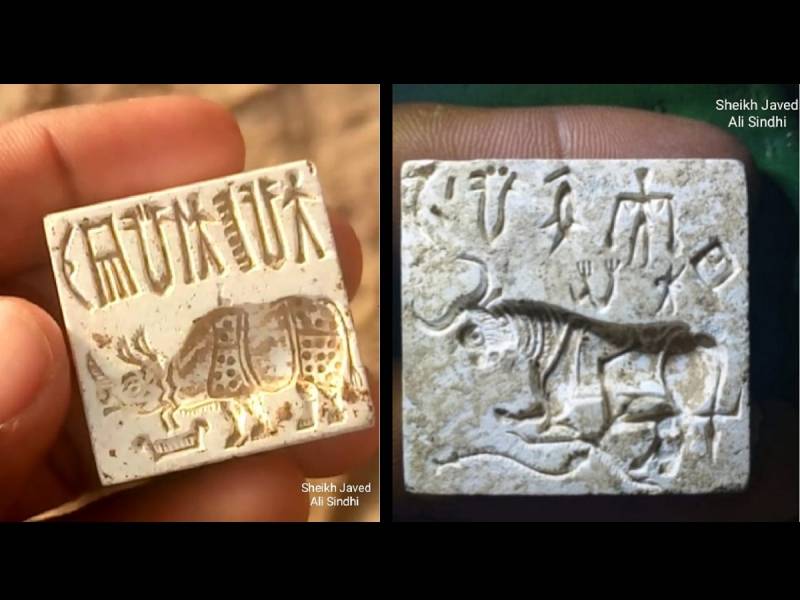
The first description of Harrapa is found in the travels of Captain Charles Masson. He was a deserter of the East India Company’s Bengal Artillery. During, many years of his wanderings, he stumbled on the ruins at Harappa in 1829, on his way to meet Maharaja Ranjit Singh, the first ruler of the Sikh Empire of Lahore. He compiled a book Narrative of Various Journeys in Balochistan, Afghanistan and the Punjab: Including a residence in those countries from 1826 to 1838. This three-volume set was published from, London in 1842. Charles Masson calls the site Haripah. He also describes the village, ruinous brick castle and a large circular mound covered with stone bangles etc. Masson writes under the title of "Arrival at Haripah," that:
"A long march preceded our arrival at Haripah, through jangal of the closest description. East of the village was an abundance of luxuriant grass, where, along with many others, I went to allow my nag to graze. When I joined the camp I found it in front of the village and ruinous brick castle. Behind us was a large circular mound, or eminence, and to the west was an irregular rocky height, crowned with remains of buildings, in fragments of walls, with niches, after the eastern manner. The latter elevation was undoubtedly a natural object; the former being of earth only, was obviously an artificial one. I examined the remains on the height, and found two circular perforated stones, affirmed to have been used as bangles, or arm-rings, by a faquir of renown. He has also credit for having subsisted on earth, and other unusual substances, and his depraved appetite is instanced in testimony of his sanctity. The entire neighbourhood is embellished with numerous Pipal trees, some of them in the last stage of lingering existence; bespeaking a great antiquity, when we remember their longevity. The walls and towers of the castle are remarkably high, though, from having been long deserted, they exhibit in some parts the ravages of time and decay. Between our camp and it extended a deep trench, now overgrown with grass and plants. Tradition affirms the existence here of a city, so considerable that it extended to Chicha Watni, thirteen tosses distant, and that it was destroyed by a particular visitation of Providence, brought down by the lust and crimes of the sovereign.”
(See: Narrative of Various Journeys in Balochistan, Afghanistan and the Punjab - London 1842, Vol I, p 452-454)
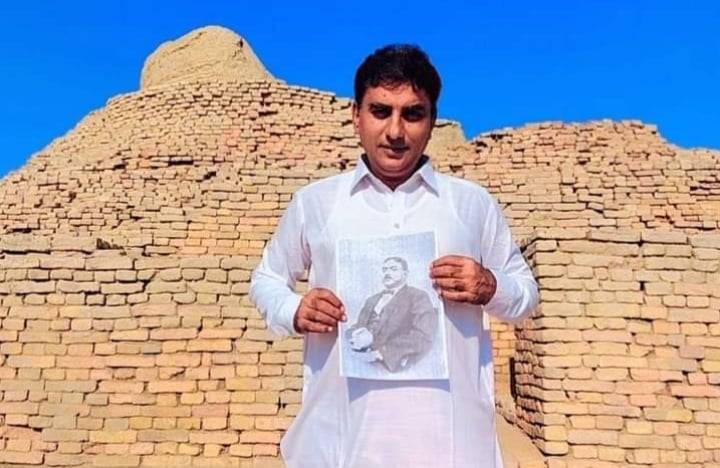
Sir Alexander Burnes at Harappa, 1831
Sir Alexander Burnes (1805-1841) was the second European who recognised Harappa as an ancient site in 1831. His 1834 bestseller Travels to Bokhara provides a description about Harappa and its neighbourhood: He describes a ruined citadel, a tomb of a Saint of the "faithful," eighteen feet in length, a large stone of annular form, a huge black slab of oval shape, and stone ring or gem, associated to giant. He found some coins in these ruins, both Persian and Hindu, but not recognizable.
(See: Travels into Bokhara: Being the Account of A Journey from India to Cabool, Tartary, and Persia, also Narrative of a Voyage on the Indus - London, 1834, Vol III, p 137)
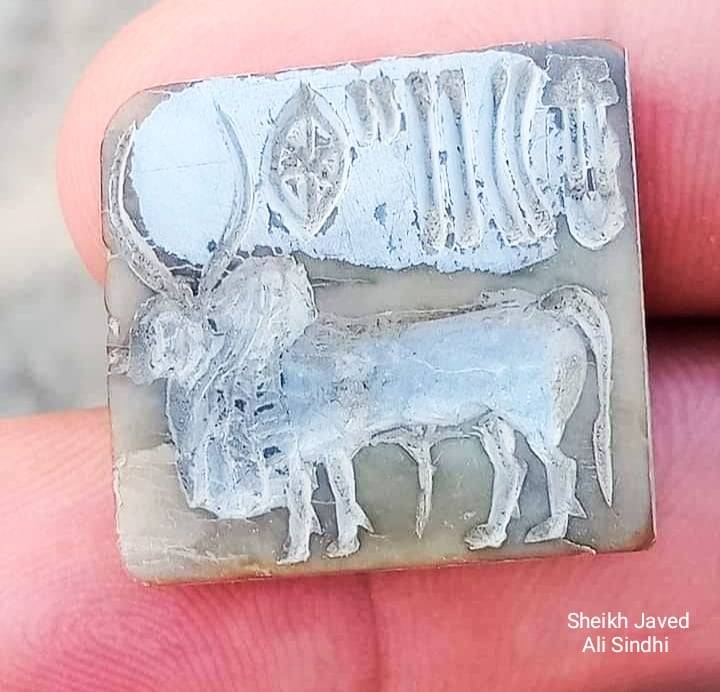
Brief Excavations of Harappa by Sir Alexander Cunningham, 1853
Sir Alexander Cunningham (1814-1893) was the founder of the Archaeological Survey of India (ASI). He visited Harappa in 1853, 1856 and 1872 when he carried out a small trial excavation. He compiled his observations and findings in the ASI Report for the year 1872-73 which was published in volume 5 of 1875 from Calcutta, India. "A Note on Harappa" by Sir Alexander Cunningham can be read on pages 105 to 108 of this report. The description of Indus Seals is worth reading in this report.
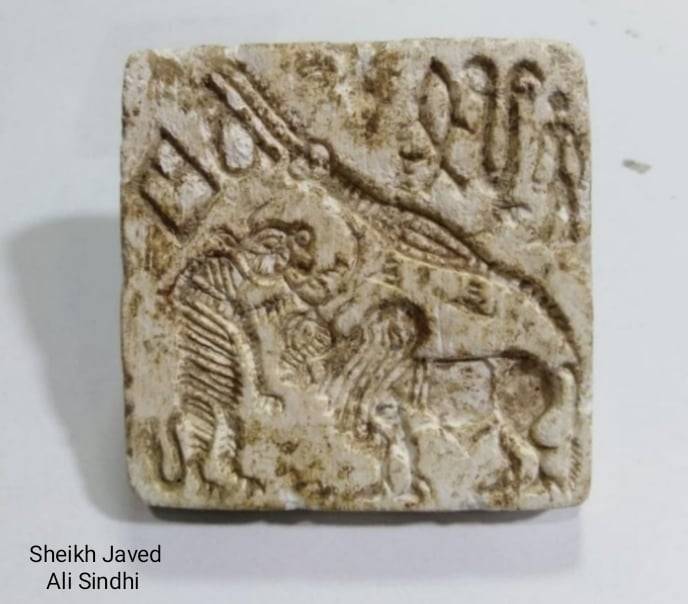
The first Indus Seal, found at Harappa, 1872
Sir Alexander Cunningham writes about Indus Seals as follows:
“The most curious object discovered at Harapa is a seal, belonging to Major Clark, which was found along with two small objects like chess pawns, made of a dark brown jasper. All these are shewn in the accompanying plate. The seal is a smooth black stone without polish. On it is engraved very deeply a bull, without hump, looking to the right, with two stars under the neck. Above the bull there is an inscription in six characters, which are quite unknown to me. They are certainly not Indian letters; and as the bull which accompanies them is without a hump, I conclude that the seal is foreign to India.. Harapa has yielded thousands of coins of the Indo-Scythians and their successors; but I am not aware of the discovery of a single Greek coin”.
(ASI Report 1875)
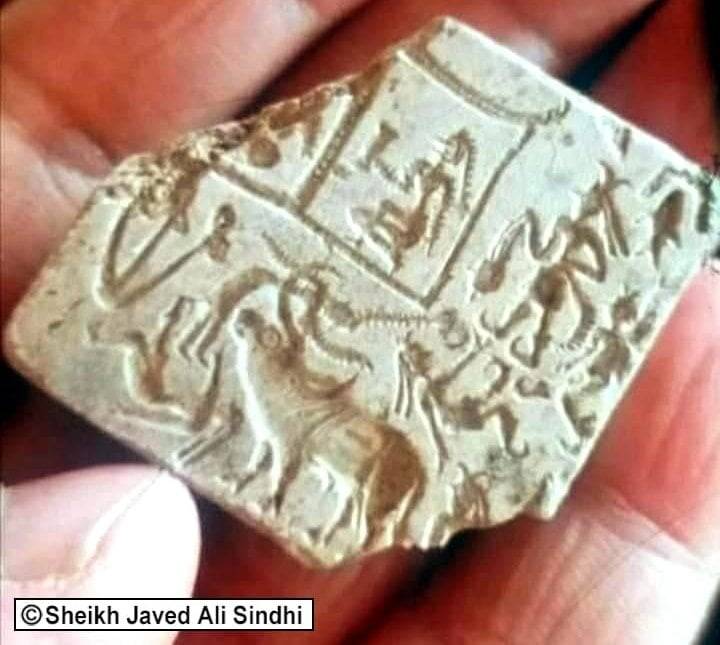
Longworth Dames discovers Second Harappan Seal, 1884
Mansel Longworth Dames, B.C.S & C (1850-1922) was an Irish Indian Civil Service Officer. He served in Bengal Civil Service India after 1870. During this he was compiler and translator of Balochi stories, folklore and language. He also served as Deputy Commissioner in British Balochistan. His first book was A Text Book of the Balochi Language: consisting of miscellaneous stories, legends, poems and Balochi English vocabulary which was published from Lahore in 1922. Under the title of "Old Seals found at Harappa," he writes that:
"In the Academy for May 2nd, 1885, M. Terrien de la Couperie, in an article on the meaning of the wordTin-Yut, refers to "the stone seal of Setchnen or Shuh writing which was found a few years ago in the ruins of Harappa, near Lahor." "This," he adds, "is attributed by General Cunningham on archaeological evidence to the fourth century B.C., and is the oldest fragment of writing found in India.
(The Indian Antiquary, Vol 15, 1886, p 1)
Another seal, apparently in the same writing, was obtained on 21 November 1884 by Mr J Harvey, Inspector of Schools, Multan:
"This seal is of a drab-coloured smooth stone, perfectly flat on the engraved side and rounded at the back. The inscription is composed of five characters. It is here given side by side with Major Clark's seal as drawn by General Cunningham. Mr. Harvey's seal (Fig. 2) is a full-sized reproduction of the original in the possession of that gentleman.
M Terrien de la Couperie is of the opinion that these seals were brought to India in the course of trade through Baktria. Probably they may have belonged to Buddhist pilgrims, who certainly must have visited Harappa. Seals in an unknown language are scarcely likely to have been articles of trade. It would be interesting to know the meaning of the inscriptions; and perhaps M. Terrien de la Couperie or some other scholar will publish a translation of them."
(The Indian Antiquary: A Journal of Oriental Research, Vol XV, 1886, Bombay, India, Page 1)
"Indian archaeologist, epigraphist and ASI Officer Hirananda Sastri visited this site in January 1909. He reported to Dr Vogel about the site’s condition. He also took part in the excavations of Nalanda and Sankissa. Sir John Marshall deputed him in the surveys of Ganga Yamuna Doab sites. Mr Hargreaves inspected these remains in I914 and suggested for further exploration and research.
(Note of John F Fleet on Seals from Harappa, 1912)
According to The Journal of the Royal Asiatic Society of Great Britain and Ireland:
“Amongst other objects of interest from this place, there are the three seals, full-size facsimiles of which are given in the accompanying Plate. The original seals are now in the British Museum, in the Department of British and Mediaeval Antiquities in charge of Mr. Read. In all three cases, the substance of these seals seems to be a claystone, hardened by heat or some other means. In the originals, the devices and characters are sunk: the illustrations represent impressions from the originals, with the devices and characters reversed, as compared with the way in which they lie in the originals, and standing out in relief. The animal on A has been held to be a bull, but not an Indian bull, because it has no hump: another opinion, however, is that it may be a male deer of some kind. The animal on C has a tail of such a nature as to suggest that this creature cannot be a deer. On A the hind legs were not fully formed and it is possible that a similar tail has been omitted there.”
A.—This seal was presented by Major (General) Clark. It was found in or before 1872-73, in circumstances which are not known. It has been figured by Cunningham in his Reports, vol. 5 (1875), plate 33, fig. 1, and in his Inscriptions of Asoka, Corp. Inscr. Indic., vol. 1 (1877), plate 38 : and another illustration of it, to accompany a note by Mr. Dames, has been given in Ind. Ant., vol. 15 (1886 ), p. 1, fig. 1. It is about 1/4'' thick: and on the back, of it there is an arched protuberance, of about the same height, at right angles to the direction of the inscription, through which there is a small hole, in the direction of the inscription, evidently for inserting a string with a view to carrying it. It is illustrated now from a plaster of Paris impression for which I am indebted to Mr. Read. The first and last letters of the inscription were not formed as fully and deeply as the others: also, owing to the shadow thrown by the rim of the impression, part of the last letter is indistinct: the full form of this letter is
B.—This seal has been presented by Mr. J. Harvey of Ballycastle, co. Antrim, Ireland, formerly of the Indian Educational Service. In December, 1885, when he was inspecting the school at Harappa, a local agriculturist came in, bringing various things, one of which was this seal and it was obtained by purchase from him: but the circumstances in which it was found are not known. This seal was first brought to notice by Mr. Dames, in his note published in the Ind. Ant., vol. 15 (1886), p. 1, where it was unfortunately figured upside-down and without being reversed. I illustrate it from an impression which Mr. Read kindly caused to be made for me. At the ends the original is about 1/4' thick. From each end the back slopes up to a height of about 7/16" at the middle: and it is there perforated by a small hole, from front to back, for inserting a string. The edges pf the seal are not quite as sharp in the original as they are in the illustration.
C.—This seal, which is now brought to notice for the first time, has been presented by Mr. Dames. It was dug up by Mr. T. A. O’Connor, District Superintendent of Police, apparently in or shortly before August, 1886; and Mr. Dames obtained it from him. It is not quite thick. As in the case of A, on the back of it there is an arched protuberance, about high, at right angles to the direction of the inscription, perforated by a small hole, in the direction of the inscription, for inserting a string. It has been damaged at the lower corner on the right. The illustration has been made by photographing the seal itself; with the result that the devices and letters do not show their relief in the manner in which this detail can be seen in figures A and B. The inscriptions on these three seals have remained, so far, undeciphered. Cunningham, indeed, in his treatment of A, though holding originally that the characters are ’certainly not Indian letters’’, proposed in his second notice to treat them as ''archaic Indian letters of as early an age as Buddha himself "
(The Journal of the Royal Asiatic Society of Great Britain and Ireland - London, 1922, p 699-701)
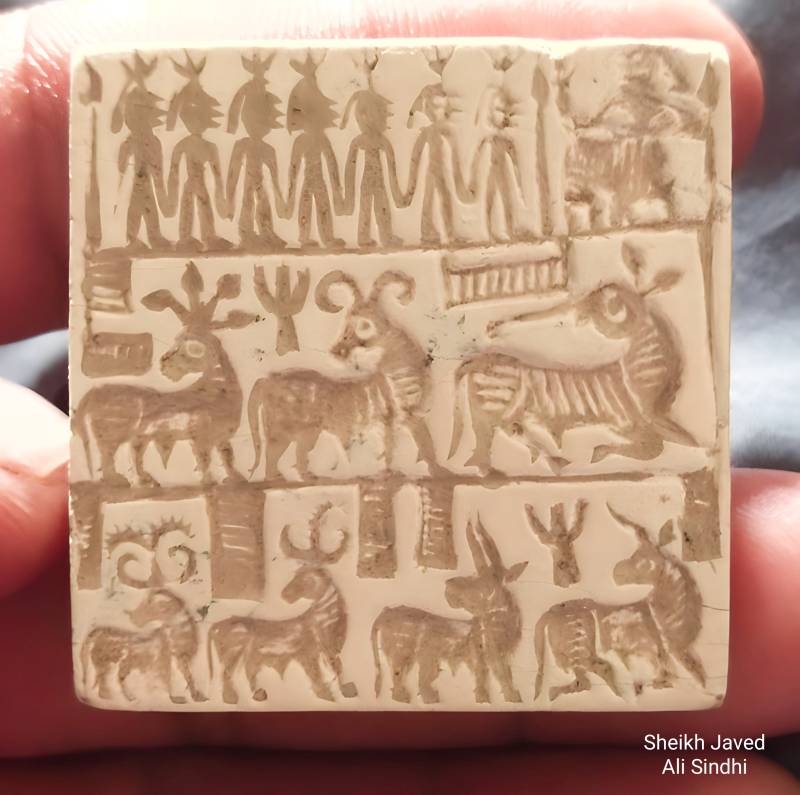
Harappan Seals excavated by Daya Ram Sahni, 1920
Rai Bahadur Daya Ram Sahni inspected the site of Harappa for the first time in 1917. The first excavations at Harappa were started by Sahni in 1920s. He started 2nd season of excavations at the site in 1923 and 1924. He writes "Harappa, District Montgomery. — The principal interest of these remains centres in the fact that they have yielded about half a dozen miniature tablets bearing inscriptions in an unknown script which has not yet been deciphered. Systematic explorations may yield more records in these characters and may thus provide a clue to their true nature and the interpretation of these curious epigraphs."
(Annual Progress Report of the Superintendent, Hindu and Buddhist Monuments, Northern Circle, for the Year ending 31st March 1917, p 7)
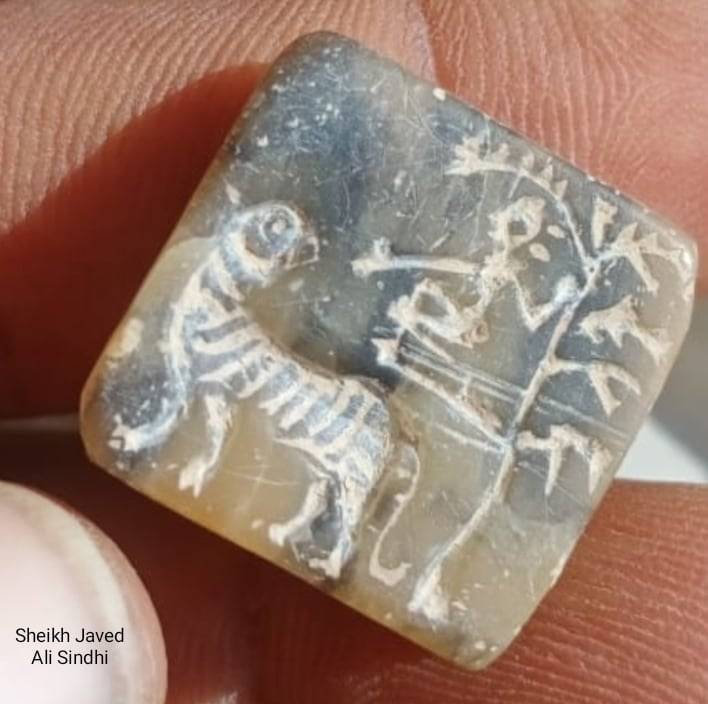
Indus Seals discovered by RD Banerji from Mohenjodaro, 1922
“We began by clearing the area in the immediate vicinity of the mud tower or stupa. At the same time a second gang was employed in clearing the debris just below the eastern retaining wall of the high platform on which the stupa had been built. The excavation along the eastern retaining wall was productive of excellent results, as during the excavations, Mr. N.S. Chikte who was in charge of the trench, made the momentous discovery of two seals with pictograms or ideograms of the same class which had been discovered up to date, only at Harappa in the Montgomery District of the Multan Division of the Punjab.”
(Mohenjodaro: A Forgotten Report by RD Banerji, 1926, p 29)
Later on, the images of 19 Indus Seals discovered from Harrapa and Mohenjodaro were published by Sir John Marshall in The Illustrated London News, on 20 September 1924. Dating of these seals (2300 BC) was done by Professor AH Sayce on 27 September 1924.
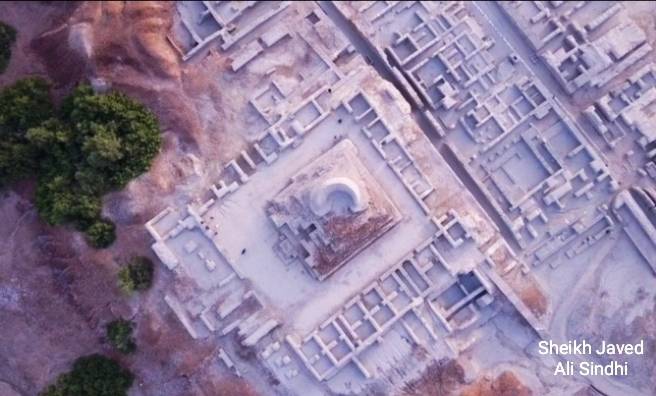
Recovery of Indus Seals from Mohenjodaro by Sir John Marshall, 1927
Sir John Marshall has given a Chapter on Indus Seals in his book Mohenjodaro & the Indus Valley Civilisation (London 1931). Its title is Chapter XXI Seals and Seal Impressions, Copper Tablets, and Tabulations.
Up to May 1927, Sir John Marshall recovered 558 specimens of Indus Seals with pictographs and animals represented. Sir Arthur Keith (1928), RD Banerji (1928), CJ Gadd (1931), Sidney Smith (1931), S Langdon (1931) and Sir John Marshall (1931) wrote on the Indus Valley Civilisation and its early script.
Sir John Marshall classified these seals in 10 different groups:-
(a) Cylinder Seals
(b) Square seals with perforated boss on reverse
(c) Square seals with no boss and frequently inscribed on both sides
(d) Rectangular seals without boss
(e) Button seals with linear designs
(f) Rectangular seals with perforated convex back
(g) Cube seals
(h) Round seals with perforated boss
(i) Rectangular seals with perforated boss
(j) Round seals with no boss and inscribed on both sides
In our time
During the last 100 years of scientific excavations and research over 3,500 seals have been found so far from archaeological sites in India and Pakistan Furthermore, such seals have also been discovered from Afghanistan, Turkmenistan, Iran, Iraq, Kuwait, Bahrain, Arabian Peninsula and Oman. Most of the seals were made of Steatite stone. A few of them were also made of terracotta, gold, silver, agate, chert, ivory and faience. The standard seal was square in shape with a 2x2 inches dimension. The colours of the seals are blue, yellow, grey, black and white.
What was the use of these Harappan Seals? According to archaeologists and experts, these stamp seals were used for religion, politics, administration, trade and commerce. These were mostly used by rulers, officials, priests, elites, chiefs, landlords, traders and merchants in the Indus cities. The Indus Seals script has not yet been deciphered but efforts are going on to solve this mystery and puzzle. Let’s hope for the best!

